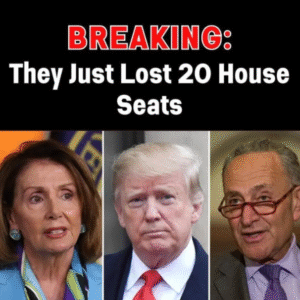The Coming Political Earthquake: How America’s Great Migration Could Reshape Presidential Elections Forever
America is on the move. Not just in the literal sense of people packing boxes and relocating—but in a deeper, more consequential way. A quiet but powerful demographic shift is underway, as millions of Americans migrate from high-cost, traditionally liberal states to lower-cost, often conservative ones. This internal migration, accelerated by remote work, housing affordability, and political polarization, is setting the stage for a political earthquake—one that could redefine the electoral map and reshape presidential elections for generations.
A New Kind of Great Migration
Historically, the term “Great Migration” referred to the movement of African Americans from the rural South to urban centers in the North during the 20th century. That shift transformed cities like Chicago, Detroit, and New York, and had profound effects on voting blocs and civil rights politics.
Today’s migration is different in composition but similar in impact. It’s driven by economic pressures, lifestyle preferences, and ideological divides. Californians are moving to Texas. New Yorkers are heading to Florida and the Carolinas. Tech workers are settling in Colorado, Arizona, and Nevada. Retirees are flocking to Tennessee and Georgia. And with every move, they bring their political identities with them.
Red States Turning Purple
One of the most visible effects of this migration is the political transformation of traditionally red states. Texas, long a Republican stronghold, has seen its urban centers—Houston, Austin, Dallas—turn increasingly blue. In 2020, Joe Biden came closer to winning Texas than any Democrat in decades. Arizona, once reliably conservative, flipped blue in both the presidential and Senate races. Georgia, too, stunned the nation by delivering Democratic victories in both the 2020 presidential election and the 2021 Senate runoffs.
These shifts are not anomalies—they’re the result of demographic change. As liberal-leaning voters relocate to red states, they alter the political balance. Suburbs that once leaned Republican are now battlegrounds. Rural areas remain conservative, but their influence is diluted by growing urban populations.
Blue States Losing Electoral Power
Conversely, blue states like California, New York, and Illinois are experiencing population declines. The 2020 Census led to the loss of congressional seats in several Democratic strongholds, while states like Texas, Florida, and North Carolina gained representation. This redistribution of seats directly affects the Electoral College, which determines the outcome of presidential elections.
As more Americans leave high-tax, high-cost states for more affordable regions, the political weight of those destination states increases. The result? A shift in electoral power from the coasts to the interior—a rebalancing that could favor Republicans in the short term, but create more competitive landscapes in the long term.
The Rise of the “Ideological Migrant”
What makes this migration particularly potent is its ideological nature. Many Americans are not just moving for economic reasons—they’re moving to live among like-minded people. Conservatives are leaving liberal cities for red enclaves. Progressives are seeking out blue bubbles in red states. This self-sorting intensifies polarization and creates echo chambers where political identities are reinforced.
But it also creates opportunities for disruption. When enough ideological migrants settle in swing districts, they can tip the balance. This is already happening in places like Maricopa County, Arizona, and Gwinnett County, Georgia—once conservative suburbs that now vote Democratic.
Remote Work and the Decentralization of Influence
The COVID-19 pandemic accelerated remote work, allowing millions to live far from their employers. This decoupling of work and location has led to a decentralization of influence. Tech workers from Silicon Valley are moving to Boise, Salt Lake City, and Austin. Creatives from Brooklyn are settling in Asheville and Santa Fe. These newcomers bring cultural capital, economic clout, and political engagement.
As these cities grow, they become new centers of power—places where national campaigns must now compete. The traditional battlegrounds of Ohio and Pennsylvania may soon be joined by Colorado, Arizona, and even parts of Texas.
The Electoral College: A System Under Pressure
The Electoral College, designed to balance representation between populous and rural states, is under increasing scrutiny. Critics argue that it gives disproportionate power to smaller states and undermines the principle of one person, one vote. Migration trends are exacerbating this tension.
As population shifts accelerate, the disparity between votes cast and electoral influence grows. A vote in Wyoming carries more weight than a vote in California. If migration continues to reshape state populations, calls to reform or abolish the Electoral College may intensify.
The Role of Policy and Governance
Migration is not just a demographic phenomenon—it’s a policy outcome. States with affordable housing, lower taxes, and business-friendly environments attract residents. Those with high costs, regulatory burdens, and perceived political dysfunction lose them.
Governors and legislatures play a key role in shaping these dynamics. Florida’s aggressive tax policies and pandemic-era openness drew thousands from the Northeast. California’s housing crisis and regulatory complexity pushed many out. These choices have electoral consequences.
The Long-Term Outlook
In the short term, migration may benefit Republicans, as red states gain seats and blue states lose them. But in the long term, the influx of liberal-leaning voters into red states could make them more competitive. The result may be a more fluid, less predictable electoral map.
Presidential campaigns will need to adapt. Traditional swing states may lose relevance. New battlegrounds will emerge. Messaging will need to reflect regional nuances. And data-driven strategies will become even more essential.
Conclusion: A Nation in Motion
America’s internal migration is more than a demographic trend—it’s a political transformation. As millions relocate, they carry their values, their votes, and their visions for the future. The result is a reshaping of the electoral landscape, a redefinition of battlegrounds, and a recalibration of power.
This is the coming political earthquake. It won’t happen overnight. But its tremors are already being felt—in state legislatures, in congressional maps, and in presidential campaigns. And as the nation continues to move, so too will its politics—forever changed by the choices of those who dared to pack up and start anew.



